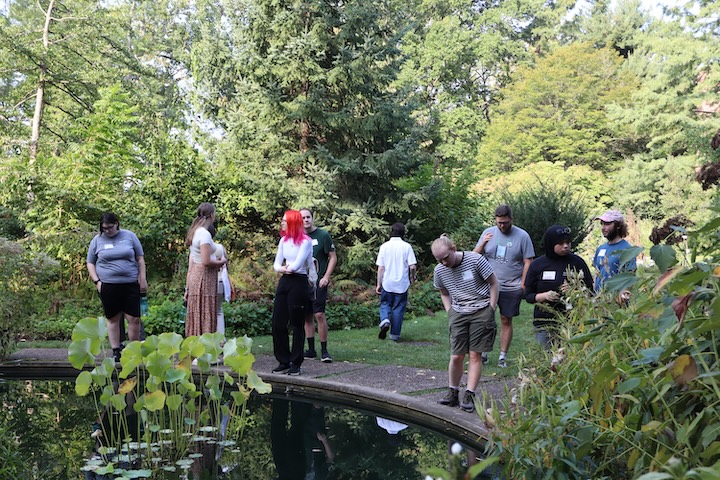Roloff helps lead project managing state hardwoods
As the fall foliage of Michigan’s forests remind us that the seasons are changing, so too does it signal another growing season has ended for Mike Walters, an associate professor in Michigan State University’s Department of Forestry, and the research he’s overseen in Michigan’s northern hardwood forests.
This summer marked the sixth year since trees were harvested from 140 30-acre forest stands, or areas of trees that share similar characteristics, across northern Michigan to identify the best ways of promoting diverse and abundant tree regeneration after harvest.

The purpose of the joint effort between MSU and the Michigan Department of Natural Resources (MDNR) — led by Walters and Gary Roloff, a professor and chairperson in MSU’s Department of Fisheries and Wildlife — is to regenerate desirable tree species that would create a more diverse and rich landscape of trees. While studies may define differently what species of trees are desirable and undesirable, Walters said this one has listed beech and ironwood trees as undesirable because of their overrepresentation within the forests, in addition to ash trees due to the threat of emerald ash borers, an invasive forest pest native to Asia.
Desirable species for this study are those that have traditionally brought timber and wildlife value to the forests, some of which are now underrepresented. These include basswood, black cherry, hemlock, northern red oak, sugar maple, white pine and yellow birch.
“Some of the factors that have contributed to poor tree regeneration in the past include low-intensity management coupled with high deer density,” Walters said.
The 140 stands are scattered across mostly state-owned forests in Michigan’s northern Lower Peninsula and Upper Peninsula that the MDNR has allowed Walters and his team to use. They’re split into four harvest treatments that vary in the ways trees are harvested from forests. Those four treatments are:
- A selection silviculture harvest: This is the way forests have traditionally been harvested in the state — or, as Walters said, “business-as-usual.” A lower-intensity harvest than the other three treatments tested, it’s a select harvest of individual and small groups of trees that happens every 15-20 years based on a stand’s condition.
- A gap-based harvest: Multiple entire patches of trees from 0.3-1.0 acre in size are removed within stands.
- A shelterwood harvest: Trees are removed to leave about 50% overstory canopy cover.
- A seed-tree harvest: Only about six to eight trees per acre remain after a stand is harvested. This creates a lot of open space with only about 10% of canopy cover left from remaining trees.
Simultaneously, two understory treatments underneath the forest stands’ multiple layers have been implemented to test which methods, in combination with overstory treatments, may be most effective in encouraging desirable seedling growth. Seventy stands use one treatment, and the other half use another. Those two treatments are:
- A leave-tops treatment: Low-value parts of treetops are left on the ground after harvesting. The idea is that deer will find it difficult to traverse through the tangled mess and seedlings will be protected and sprout from it.
- An herbicide and scarification treatment: Competing vegetation, including shrubs and undesirable tree regeneration, is sprayed with herbicides, and the soil is loosened up to encourage the germination and growth of desirable tree species.
The leave-tops treatment is in its sixth year following the harvest, while the herbicide treatment is in its third because of a need to let vegetation grow before herbicides were applied.
This summer, Walters and a team of undergraduate and graduate students from MSU and institutions across the country surveyed tree regeneration from the 6-year leave-tops sites. Measurements are done at six and 10 years. Walters said six years is an important time to evaluate regenerating trees because it indicates how the stands will grow in the future.
“It gives us a pretty good idea of what’s going to happen (in the stands) 40-50 years down the line,” Walters said. “Those seedlings that are able to grow taller than deer — which is about one and a half meters — represent the next generation of trees on the sites.”
Along with tracking tree regeneration following different harvest and understory treatments, the team wanted to also understand how the treatments impact other kinds of vegetation growing on the forest floor. Specifically, crew members wanted to know whether the new treatments being tested might have negative impacts on vegetation communities, such as the proliferation of more weeds or invasive plants.
Helping to gather data were Alison Staelgraeve, a 2021 MSU Fisheries and Wildlife graduate, and Christian Tibaudo, a current senior studying both fisheries and wildlife, and forestry.
With financial support from the MDNR and in-kind support in the form of expertise and resources from the MSU Herbarium, they spent the summer identifying different species of plants in the understories of stands with a leave-tops treatment. Staelgraeve said they spotted about 285 different species in the northern Lower Peninsula and about 295 in the western Upper Peninsula.
“We wanted to know (in the leave-tops treatment) what happens to the ground layer of plants when different types of harvests occur,” Tibaudo said.
Results from this summer are scheduled to be published early next year.
Read the full story in AgBioResearch.



